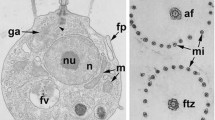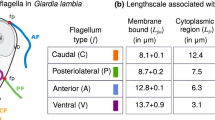Summary
Flagellar development during cell division was studied inCyanophora paradoxa using agarose-embedded cells, Nomarski optics and electronic flash photography. The cells bear two heterodynamic and differently oriented (anterior and posterior) flagella. Prior to cell division, cells produce two new anterior flagella while the parental anterior flagellum transforms into a posterior flagellum. The parental posterior flagellum remains a posterior flagellum throughout this and subsequent cell divisions. The development of a single flagellum thus extends through at least two cell cycles and flagellar heterogeneity is achieved by semiconservative distribution of the flagella during cell division. Based on these principles a universal numbering system for basal bodies and flagella of eukaryotic cells is proposed.
Similar content being viewed by others
Abbreviations
- APF:
-
anterior parental flagellum
- PPF:
-
posterior parental flagellum
References
Beech PL, Wetherbee R, Pickett-Heaps JD (1988) Transformation of the flagella and associated flagellar components during cell division in the coccolithophoridPleurochrysis carterae. Protoplasma 145: 37–46
Bothe H, Floener L (1978) Physiological characterization ofCyanophora paradoxa, a flagellate containing cyanelles in endosymbiosis. Z Naturforsch 33 c: 981–987
Farmer MA, Triemer RE (1988) Flagellar systems in the euglenoid flagellates. Biosystems 21: 283–291
Höhfeld I, Otten J, Melkonian M (1988) Contractile eukaryotic flagella: centrin is involved. Protoplasma 147: 16–24
Kies L, Kremer BP (1986) Typification of theGlaucocystophyta. Taxon 35: 128–133
Kies L, Kremer BP (1989)Glaucocystophyta. In: Margulis L, Corliss J, Melkonian M, Chapman DJ (eds) Handbook of Protoctista. Jones & Bartlett, Boston (in press)
McFadden GI, Melkonian M (1986) Use of Hepes buffer for microalgal culture media and fixation for electron microscopy. Phycologia 25: 551–557
Melkonian M, Reize IB, Preisig HR (1987) Maturation of a flagellum/basal body requires more than one cell cycle in algal flagellates: studies onNephroselmis olivacea (Prasinophyceae). In: Wiessner W, Robinson DG, Starr RC (eds) Algal development. Molecular and cellular aspects. Springer, Berlin Heidelberg New York Tokyo, pp 102–113
- (1989) The flagellar developmental cycle in algae: a progress report. Prog Phycol Res (in press)
Reize IB, Melkonian M (1988) A new way to study flagellated/ciliated protists in the light microscope: immobilization of cells in agarose or carrageenan. Eur J Protistol (submitted)
Schlösser UG (1982) Sammlung von Algenkulturen. Ber Deutsch Bot Ges 95: 181–276
Sleigh MA (1988) Flagellar root maps allow speculative comparisons of root patterns and of their ontogeny. Biosystems 21: 277–282
Wetherbee R, Platt SJ, Beech PL, Pickett-Heaps JD (1988) Flagellar transformation in the heterokontEpipyxis pulchra (Chrysophyceae): direct observation using image enhanced light microscopy. Protoplasma 145: 47–54
Author information
Authors and Affiliations
Rights and permissions
About this article
Cite this article
Heimann, K., Reize, I.B. & Melkonian, M. The flagellar developmental cycle in algae: flagellar transformation inCyanophora paradoxa (Glaucocystophyceae) . Protoplasma 148, 106–110 (1989). https://doi.org/10.1007/BF02079329
Received:
Accepted:
Issue Date:
DOI: https://doi.org/10.1007/BF02079329




